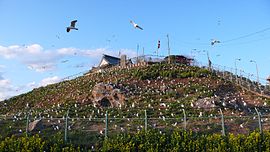Kabushima
Native name: 蕪島 Nickname: Seagull Island | |
|---|---|
 | |
| Geography | |
| Location | Hachinohe, Aomori |
| Coordinates | 40°32′20″N 141°33′27″E / 40.53889°N 141.55750°E |
| Length | 300 m (1000 ft) |
| Width | 140 m (460 ft) |
| Coastline | 800 m (2600 ft) |
| Highest elevation | 19 m (62 ft) |
| Administration | |
Japan | |
Kabushima (蕪島) is a small island located in Hachinohe, Aomori, in the Tōhoku region of northern Japan. Part of the Tanesashi Coast, it was incorporated into the Sanriku Fukkō National Park from May 2013.
Geography
[edit]The island has a length of 300 meters (980 ft) and a width of 140 m (460 ft). The highest point of the island measures 18 m (59 ft) in elevation. The total area of the island is approximately 0.017 km2 (0.0066 sq mi). Although called it is an island, it is connected to the mainland by a causeway constructed in 1942 so that people may walk to it from the shore.
Important Bird Area
[edit]The island is noted as a nesting ground for Black-tailed gulls and has been protected as a National Natural Monument of Japan since 1922.[1] It has also been recognised as an Important Bird Area (IBA) by BirdLife International.[2] The sound of the umi-neko at Hachinohe was selected by the Ministry of the Environment as one of the 100 Soundscapes of Japan.[3]
Kabushima Shrine
[edit]
Kabushima Shrine (蕪島 神社, Kabushima Jinja) is a small Shinto shrine located on Kabushima island. The shrine is a branch of the Itsukushima Shrine and is dedicated to Benzaiten. According to shrine legend, it was established in 1269 by local fishermen. The shrine burned completely down on 5 November 2015,[4] but it was rebuilt and expanded at the cost of 5 billion yen. The shrine reopened on 26 March 2020 after a small reopening ceremony. The ceremony was scaled down due to the COVID-19 pandemic.[5] The main festival of the shrine is held on the third Sunday of April.
References
[edit]- ^ [https://kunishitei.bunka.go.jp/heritage/detail/401/89 蕪島ウミネコ繁殖地 - Agency for Cultural Affairs database (in Japanese)
- ^ "Kabushima islet". BirdLife Data Zone. BirdLife International. 2021. Retrieved 27 January 2021.
- ^ "残したい日本の音風景100選" (PDF). Ministry of the Environment. Retrieved 18 March 2017.
- ^ "ウミネコ繁殖地の蕪島、蕪嶋神社が全焼 放火の可能性も". Asahi Shimbun. 5 November 2015. Retrieved 5 November 2015.
- ^ "蕪島神社、再建の社殿披露 15年に焼失、青森・八戸" [Reconstruction of Kabushima Shrine, after it burned down '15, Aomori, Hachinohe]. The Nikkei (in Japanese). 26 March 2020. Retrieved 18 April 2020.
External links
[edit]![]() Media related to Kabushima at Wikimedia Commons
Media related to Kabushima at Wikimedia Commons
- Hachinohe City tourist information(in Japanese)
- Official website (in Japanese)
- Kabushima on Nippon-Kichi
Text is available under the CC BY-SA 4.0 license; additional terms may apply.
Images, videos and audio are available under their respective licenses.

